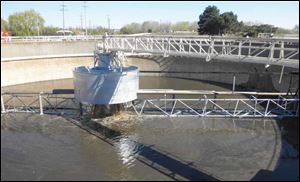
Monroe’s aging water plant set for improvement
New ozone generator to address taste, odor issues
12/31/2013
Monroe water treatment plant.
MONROE — Monroe is moving closer to heading off any future taste-and-odor problems with the tap water it distributes by replacing one of two ozone generators at a cost of $818,393.
And although the new equipment is not the primary line of defense against western Lake Erie’s toxic algae, the technology provides the ancillary benefit of helping fend off that annual threat to some degree, too, said Barry LaRoy, Monroe Water and Wastewater Utilities director.
The new ozone generator is to become operational by Aug. 15.
It may not be the sort of thing residents notice when they open their taps.
But Mr. LaRoy said it’s an important upgrade that should ensure continued operation of the 90-year-old plant, part of a master plan of improvements being phased in.
“It’s been planned for a while,” Monroe City Manager George Brown said. “It’ll be a much better technology and cheaper to operate.”
The purchase was approved by a 6-0 council vote on Dec. 23. Councilman Jerry McKart was absent.
Monroe is Michigan’s only city to draw its water from Western Lake Erie, Mr. LaRoy said.
Toledo and Port Clinton also draw their water from the shallow western basin.
Injecting ozone into the water after it’s been pulled from the lake is part of Monroe’s first-treatment process to improve taste and remove odors, he said.
Monroe has factored in costs of renovating the plant’s ozone building, built in 1975, to accommodate the new equipment. That will include raising the chamber roof to extend the building’s life. It also will allow equipment to operate more reliably and efficiently, Mr. LaRoy said.
The main part of the water plant opened on March 1, 1924.
The plant’s ozone capacity also is being increased to help fend off toxins found in western Lake Erie’s most prevalent form of harmful blue-green algae, microcystis. The main toxin in that algae is called microcystin.
The ozone generators were installed in 1997 and 2001, but the first one has broken down. It is being replaced with a larger generator.
Design modifications will allow the city to eventually install a third ozone generator to help increase the plant’s treatment capacity, Mr. LaRoy said.
“When the lake begins with any algal episodes, we have to alter treatment normally,” he said.
The city has real-time monitoring equipment to detect the toxin at the raw water station it co-owns with Frenchtown Township, Mr. LaRoy said.
Monroe became part of a regional monitoring system in 2012, one rooted in chemical spills.
According to the Michigan Department of Environmental Quality, more than 700 spills have been documented along the St. Clair River corridor since 1986. Many have been on the Canadian side.
The St. Clair River connects Lake Huron and Lake St. Clair, the latter of which flows into the Detroit River and from there into western Lake Erie.
One of Lake Erie’s worst algae outbreaks occurred this summer. It wasn’t as large as the record 2011 bloom.
But the toxin was so concentrated in the Oak Harbor area that it overwhelmed a water-treatment system that serves 2,000 residents of Ottawa County’s Carroll Township.
That event was the first in Ohio history to cause an emergency closure of a water plant because of algae toxins. Residents were provided bottled water until the township was able to get uncontaminated tap water from Port Clinton. The township flushed out its system and put its plant back into service after the threat subsided.
Contact Tom Henry at: thenry@theblade.com or 419-724-6079.